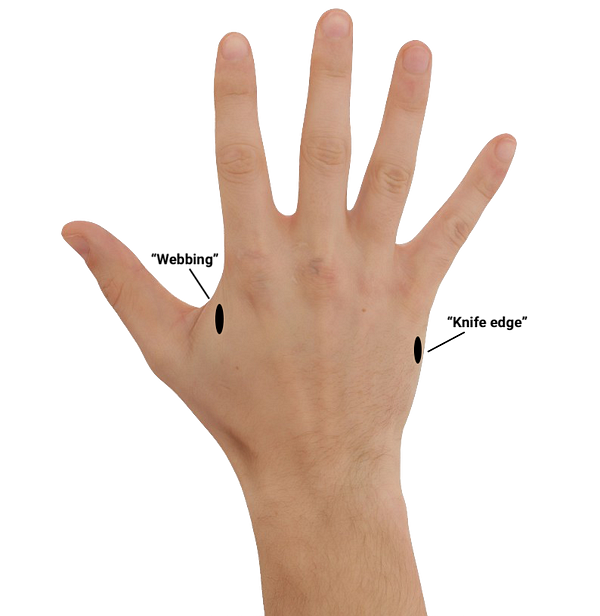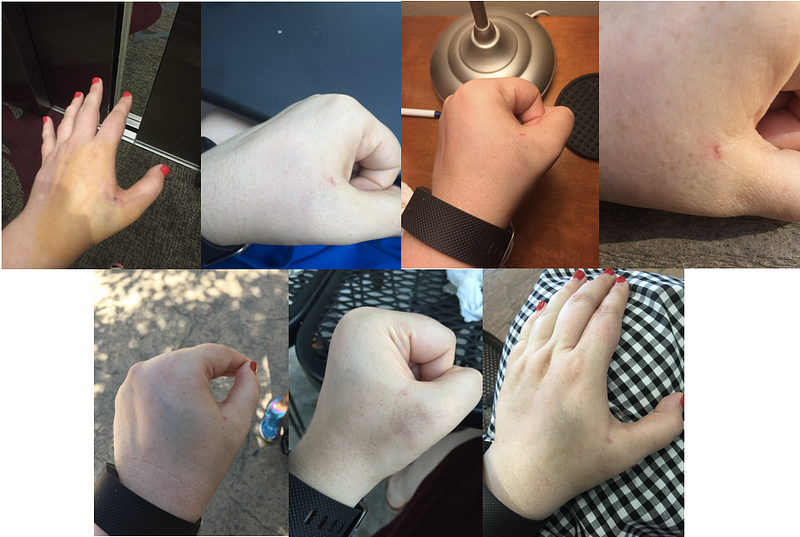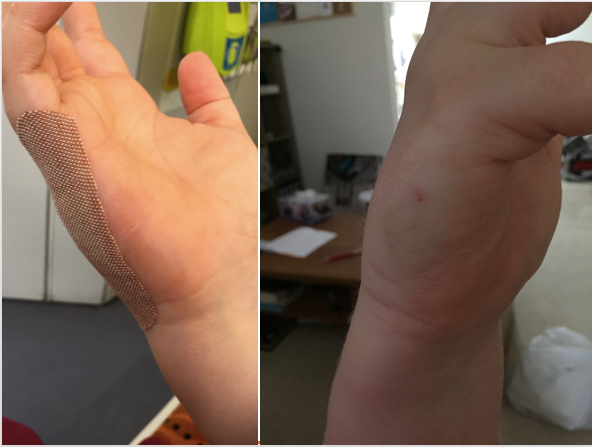I’m Kayla and I’m doing my PhD part time.
“Oh, what’s your PhD on?”
This is the first question that starts it all. Then I have to decide whether I want to have this conversation- right now, with this particular person- or not. Whether I play the “I’m just a researcher” card, or actually reveal that I, myself, have 2 microchips inside my body for part of this research — depending on how I think they’ll react.
I’ve been researching devices that go inside the body for non-medical purposes for just over three years now and there are predictable questions I get asked over and over again when someone finds out what I research, and that I have 2 microchips inside my body. These same questions pop up on social media every time I appear on TV or in the news.
Some people refused to believe the reality of how these chips work, and there’s no point trying to change these minds; the “the Government is secretly tracking you with a microchip you received at birth, it’s all about the New World Order and they’ll switch you off if you don’t comply” crowd.
This post is not for them. This post answers the FAQs for people genuinely interested in learning about the technology and educating themselves on the reality. These are all real questions I receive:
How long does it take to heal?
What if it breaks? Is it safe?
What can’t it do? What are the limitations?
What if someone cuts off your hand?
What happens if you moved / get fired?
Does it go off at airports? How about x-rays or MRIs?

“Webbing” and “Knife Edge” of the hand
This depends on personal preference. The standard position for a microchip is in the webbing of the hand, due to the short read range, flexibility to bring up to the reader and the lack of major nerves or blood vessels in the area. Some have chosen other locations, due to greater flexibility and ease of use of bringing it up to a reader. For example, the “knife edge” of the hand may be easier to present your chip up to a reader, depending on the reader location, particularly when holding other things. Others have chosen the wrist or along the thumb.
They are injected using a large gauge syringe (like a body piercing or an IV drip) after the area is cleaned with antiseptic. The needle is placed into the hand and plunger pushed to dispense chip . An adhesive bandage may be used depending on how quickly you clot and scab over the injection site.
You can see a video of the procedure below — PSA there is blood. Don’t watch if you’re squeamish. Watch the video under it that shows the microchip coming out of the needle outside of the body.
Below is a video of getting the second chip — an RFID Microchip inserted into the “knife edge” or “karate chop” side of the hand. It didn’t go as smoothly as planed so quite a while was spent pushing the chip in, and I stopped filming as I was getting nauseous and needed to have some sugar so I didn’t pass out!
Honestly, a bit. This of course depends on your individual pain threshold but the majority of people find it hurts as much as a needle (think an IV), a body piercing or a bee sting. The microchip insertion is over in just 30 seconds as you can see in the videos above. Personally, the knife edge hurt more than the webbing.
Below is an excerpt from my writing at the time I got the first chip inserted.
I’m sitting in a body modification studio, not something I’m unfamiliar with but this time it’s different. I’m not getting a new piercing, I’m getting an NFC microchip inserted into my hand.
The syringe is the same as all the others for large gauge piercings. It pinches, but it’s not too painful. There’s a lot of blood, but I’m a bleeder so I was expecting this.
I start to feel nauseous, I tell the piercer and he tells me to sit back. I start to feel light header and dizzy. He gives me some coke to sip and moves everything out of my way in case I faint — I’ll fall one way or another.
It starts to go black at the corners of my eyes — just like in the cartoons. I tell him I’m going to black out. He lies me down and puts a cool compress on my head and tells me to keep talking to him so he knows I’m still conscious. He helps me sit back up for another sip of coke and after a few minutes it’s passed. I’m fine.
I’ve never reacted like this before, and he tells me it’s probably because I could see the blood this time, rather than a piercing or a mole being cut out from the back of my neck, and my brain starts freaking out because it can’t connect what’s happening.
I’m bruised where the chip is, but I’m the kind of person that bruises from a massage or the jets of a spa bath, so I was expecting this. The injection site doesn’t hurt very much, just like a normal needle even though it’s much bigger. Where the chip is sitting aches for the first 18 or so hours. I had a bit of trouble sleeping and it constantly mildy ached — like a pulled muscle or something.
After the first 18 hours it doesn’t hurt unless I particularly move or touch the area that the chip is in. The bruising remains for a few days. After it heals I’m not aware of the chip at all. I can touch it without pain and feel the chip under the skin (like I could with the Implanon) but there’s no pain.
This also depends person to person. You will likely have some bruising and swelling for up to a few days. Follow any after care instructions you’re given once it’s inserted and you should be fine. Typically people find it heals in a few days — much quicker than, say, a piercing as the device is fully encased in the body, while a piercing is an open wound with a bit of metal through it! You will be able to return to normal activities immediately and most people can start using the device straight away. You may notice that the read range gets better once the swelling has gone down.

Image of my hand healing after getting my first mircochip in May 2016

Image of my second microchip healing, November 2016. This position bruised far less
About the size of a grain of rice. This depends on the microchip you have chosen, and the supplier.
Microchip size comparisons
I got it done at a body modification / tattoo parlour. Where people get it done is something my research looks at. Some people get them done at their doctor or get a friend to do it. This can be a friend with medical training, some other related training (e.g. a vet) or no training whatsoever. Some people self insert, but I wouldn’t recommend that as it increases the risk of infection and can go too deep which effects the read range. If your body modification store doesn’t sell the microchips you can buy online from Dangerous Things and take it along with instructions to them.
Not really. This depends on the location chosen and how much fat you have in that area. Some people you can see the outline of the microchip, while others you can’t. Also depending on how well you heal you may have a small scar left behind. In many cases this scar is not noticeable; if you weren’t looking for it, you wouldn’t see it.
Image of my 2 microchips after healing
A more visible microchip
Once healed you cannot feel the device, just like with piercings — at first you are very aware of them but once it’s healed you don’t notice them at all unless you touch them. You can feel the chip under the skin if you touch the skin above — which is typically what people are really asking when they ask this — yes you may feel it (probably). I make that judgement on a case by case basis.
As with anything going into the body there is a risk of infection. The person who inserts the device should clean the area first with antiseptic to reduce this risk.
There is also a small risk of the device breaking with an impact, however thousands of microchips have been inserted and there are no reports of breaking. The microchips have been tested by Dangerous Things, in chicken, and the chips survived impacts that destroyed the chicken flesh and bones. For the chip to break, you would have already seriously injured your hand. Personally, I’ve fallen off a horse and hopefully that’s the largest impact they will ever take!
As for cancer or long term effects, we don’t have definitive proof either way, however there are years of canine and feline insertion without any negative health impact reported.
The why is a personal reason for each person, something my research is looking into; for some it’s just for a convenience-based reason (e.g. I was sick of losing my keys / locking myself out), while for others it’s about pushing the boundaries of what it means to be human and being at the forefront of evolution.
For me, it’s part of my PhD research.
The microchips are commonly used for access and authentication. For example, you can:
Unlock your smartphone (Android & Windows only)
Unlock your computer (with a peripheral device)
Unlock a compatible lock; install, or make, a door lock for your home e.g. https://www.bunnings.com.au/samsung-smart-keyless-deadbolt-digital-door-lock_p4220496
Unlock your car if you modify your car locking system
Access other security systems (e.g. work or gym access, printer service, office vending machine) if you add the unique number of your chip to security systems or clone an existing compatible pass on to your chip. At some gyms in Sweden the infrastructure is set up to simply add your chip as a valid key.
I find the “knife-edge” more convenient as I’m often walking up to the door with stuff in my hands. See:
http://www.kaylaheffernan.com/blog/2018/4/23/the-ux-of-using-a-microchip-foraccess
They are also used to launch items on your, or someone elses, phone (newer iPhones, Android & Windows). For example:
A contact to share (e.g. use as a business card)
A website to open
Apps your use all the time (e.g. if you search a specific address regularly, you can program it to launch Google Maps with your selected address all ready to go, or launch an app you use all the time e.g. a text message ready to send.)
We also used microchips as a VIP ticket at PauseFest 2018, where 11 of us could scan into the conference rooms using the chip instead of using a wearable badge.
I also used it as my ticket on the train in Stockholm Sweden on SJ Rail.
And was also a clue in the scavenger hunt at Buzzconf, however the usability of being scanned by a bunch of strangers was limited — similar to my experiments with the NFC ring. I’ve only shared my contact details using the microchip once in a non-staged scenario.
The chips cannot hold more than one unique ID at once. This means if you want to do more than one thing you need to have access to the security system to add your chip’s ID to it (and that all the systems use the same numbering convention and can read your chip).
You should not expect your USB reader or mobile device to achieve the same read range that you normally get with a label tag or card style tag as the chip’s antena is smaller and the reading devices are designed to read large flat tags. You can see some difficulties with reading the chip in the videos above. I personally can’t use my chip in the stairwell at work as the readers in there are older and weaker.
The chips cannot be used for cloning credit cards or PayWave.
There is no GPS tracking capabilities in the chips. You cannot be tracked or geo-located from the chip. The chips are passive and contain no batteries. Just like no one could magically find you from you Credit Card when it wasn’t in use.
As you can see from the videos the read range is at best a few centimetres, so creating a device to read the RF chip is also not possible.
No one can use the chips to track you. We already carry a massive geo-locator in the form of your phone, so there’s no point of anyone microchipping you to track you — they could do that anyway with your phone,
I mean, I guess that would suck. But I also don’t think it’s likely to happen. You can smash down my door with brute force a lot easier than cutting off my hand. Just like we haven’t seen fingers been cut off with the advent of fingerprint smartphone unlocking, we’re not going to see this. It’s a big jump from B&E to bodily harm of another person. Plus you have to know where I live for that to be of any use.
As for “stealing” the UID of a microchip you would have to:
Be aware that I have a chip and where it is
Build something large enough to read my size of a rice grain sized chip from a distance
Or, get close enough to be physically touching me to get the UID off my chip (or knock me out so you can do this)
Clone the UID onto something
Find where I live
Like trying to clone a credit card from someone walking past on the street — much easier to steal the physical thing! And if you did steal a random strangers keys off the street you still have to know where they live to make that of any use. It’s not a very smart crime, so I’m not particularly worried about this.
No, they don’t have to cut off my hand 🙄 (again).
The chips are reprogrammable, so if the new office uses the same frequency and is compatible with your chip you should be able to continue to use it (by either adding the UID of the chip to the system, or cloning your pass onto the chip). Leaving a job with the chip is just like if you left with, or lost, your physical pass — presumably the security system allows deleting / deactivating of these cards.
Yes. The microchips do not have a bio-bond coating like microchips in animals. However, depending on how deep your chip is inserted the removal can be of varying degrees of difficulty. At its easiest, it’s like removing a really bad splinter — a small cut a few millimetres wide and tweezers to pull it out.
Personally, I don’t plan to take mine out unless it started causing problems. Even if I stop using them, they are bio-compatible so my body doesn’t notice they are there. It would actually be more bother to remove them.
No. The amount of metal in the chips is so small that it goes not set off the machines at airports. They are also not visible in the full body scanners — these are designed to look under clothes, not underneath the skin.
If you have an X-ray you will be able to see the chip, but it will not affect the chip.
X-Ray of my microchips
MRI machines of the 1T, 1.5T, and 3T strengths should also be just fine. There is blurring of the image around the area of the tag, but the tag itself is not effected.
I’ve genuinely had someone ask if their ex could have microchipped them because he kept tracking them down. In this case, it’s more likely that someone is using your phone or watching your activity on social media.
Given the microchips have no tracking capabilities, it seems pretty pointless that someone would microchip you against you will. If you think you’ve been chipped, read this https://forum.dangerousthings.com/t/so-you-think-youve-been-implanted-against-your-will/64
Probably not. The passage in Revelation 13:15–18 reads:
“Also it causes all, both small and great, both rich and poor, both free and slave, to be marked on the right hand or the forehead, so that no one can buy or sell unless he has the mark, that is, the name of the beast or the number of its name.”
Many people get their microchip in their non-dominant hand, which is the left, so we’ve pulled a fast one on the devil right out of the gate.
Also, the chip doesn’t have the name or number of the beast on it, each chip has a unique number. So, maybe just one persons UID happens to be the mark of the beast — who knows!
And finally, we can’t buy with the chips currently as they lack payment capabilities. Plus, there are plenty of other payment options even once the capabilities are there.
Something else?
Ask me in the comments!





